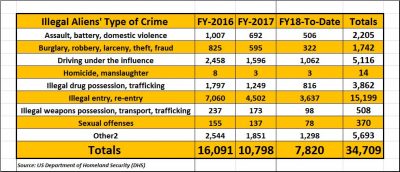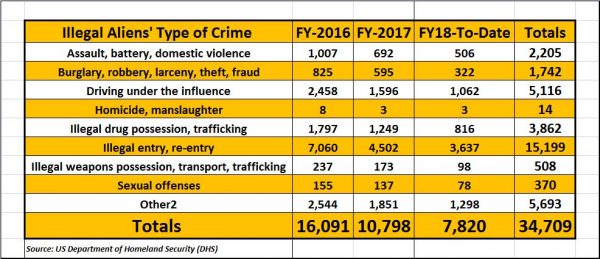Commentary: Why No Coverage of this by US Major Media?
By Kumar Balani
There were nearly 35,000 crimes of various types committed by illegal aliens in fiscal years 2016 and 2017 and in the 11 months of 2018 up to August 31 of that year, according to the United States Customs and Border Patrol or CBP, one of the seven components of the Department of Homeland Security. Descriptive details on the types of crimes and the totals for each type of crime committed in each year, and the totals for each of three years are shown in the table below.
While the largest number of crimes – more than fifteen thousand or about 44 percent of the arrests and convictions of illegal aliens – were for unlawful entry or reentry, all the other crimes – 19,510 offenses or 56 percent – caused financial, medical, physical, psychological or sexual harm, impairment, or damage to the hapless victims, or led to their deaths.
This includes crimes such as ‘driving under the influence’ of alcohol or drugs or narcotics, or the possession, trafficking and transport of deadly weapons and drugs – that resulted in, or had the potential to result in harm to, or death of people.
The range of crime types during this three-year period was so wide that almost 5,700 or one of every six crimes were placed under the category of ‘other’. Needless to say, these ‘other’ un-categorized crimes caused bodily harm as well, or death.
The United States, like other countries, provides various means for people who entered it, to adjust their status from illegal to legal, temporary-stay nonimmigrant visa status for various purposes, such as business, study, tourism, or other activity. Before the expiry of any of these visas, the nonimmigrant visa holder, with the assistance of a practicing attorney on immigration law, can apply for permanent residence, if eligible. Conviction of crime makes it more difficult.
In extensive and intensive browsing of the websites of major news media in the United States, since early June 2016 when the campaigns for the US presidency were in full swing and up to now in January 2019, we at BIZ INDIA Online News found not even a single news report providing any compilation of data on crimes committed by illegal aliens. To fill that gap and to point out its omission is the purpose of this commentary.
We searched inside the websites of major national newspapers, magazines, and broadcast news media such as radio stations and television channels using the search key phrases “illegal aliens” and “illegal aliens’ crimes”. We found nothing.
During the 2016 presidential campaigns of Hillary Clinton, Bernie Sanders and Donald Trump, we often wondered why there was a total lack of coverage in US major news media on such important news on illegal aliens’ crimes that affect the security and safety, in terms of protection against bodily harm, hurt, and death, of over around 325 million people in the US.
That wonderment continues until today why there is still no coverage, as the issue of crimes by illegal aliens was brought up again by President Trump while campaigning for Republican candidates for Congress during recent US midterm elections that held on November 6, 2018.
To have practically zero coverage of tens of thousands of crimes documented by US government agencies as shown in the table that we’ve put together here, makes us wonder about the possible reasons for the omission of such important news by US news media on the Internet, in print, on radio, and on television.
The omission of news of crimes by illegal aliens is, in our view, simply inexcusable. This omission is especially unconscionable because such crimes have impacted the victims by causing “financial, medical, physical, psychological or sexual harm impairment, or damage to the victims, or led to their deaths,” as we have pointed out above.
Our search for details of crimes committed by aliens illegally crossing through the US-Mexico border was first motivated by the journalistic imperative to get specifics of such crimes after frequent mentions by presidential candidate Donald J. Trump about Mexicans who, he had said repeatedly in his campaign rallies, were illegally coming in daily as “drug dealers, MS-13 gang members, murderers, and rapists.”
This was his justification for his repeated promise: “We’re gonna build a big beautiful wall.” But the subject of whether a wall between the United States and Mexico should be built, is not within the tight scope of this current commentary on illegal aliens’ crimes.
There’s way too much information, pro and con, on the subject of building a wall on the 1,954 US-Mexico border to consider, before writing an article that does justice to that important subject. It’s an interesting question for a future commentary piece, with surprising facts both for, and against that project, as well as perspective and insight available for both the pro and con sides of this issue that has become so controversial today.
Looking at a larger, illegal-alien entry problem, note that over the 28 years from 1990 to 2017, there were nearly 26 million people who entered the United States illegally, according to the General Accounting Office. The GAO points out that for the year 2011 “the United States Customs and Border Patrol or CBP only intercepted sixty-one percent of individuals illegally crossing the border in 2011, which translated to 208,813 individuals not apprehended, and 85,827 of the 208,813 would go on to illegally enter the United States.
In that report on Wikipedia, no statistics were available from GAO for any of the other years, prior to or after 2011, about the number or percentage of intercepted aliens who went on to enter the United States illegally.
If we apply the same percent to the nearly 26 million as the GAO has done for 2011 – around 41 percent – who went on to enter the United States illegally without being caught, that number comes to around 11 million illegal aliens in the United States. That is a number that has often been cited in news media as the total number of illegal aliens in the US.
But what about the number of aliens who entered the US illegally in all the decades before 1990 and were never caught ? Does any US government agency have such information?
As early as in elementary school in Manila, Philippines, we (classmates) learned the various essential requirements of good journalism, particularly in the straight-news reporting format. Some of these essentials are: accuracy, balance, clarity, fairness, impartiality, and especially perspective, which means no omission or downplaying of facts that do not confirm to a media organization’s leaning or stance.
Among optional qualities to enhance that reporting are insight and providing a clear understanding of the subject covered. These were reinforced in our high school-level journalism workshops and practice, and later on in college, in the professional education and training in journalism of colleagues at the Institute of Mass Communication at the University of the Philippines.
A reporter’s opinion, stance, or view, has no place in a straight-news reporting, the journalism professor emphasized in high school-level workshops. So these days when I read front-page straight news reports in US newspapers, this question comes up in my mind over and over: Is this the writer’s personal opinion? If so, should it not be in the Opinion or Commentary section?.
Is it any surprise that in a January 2018 Pew Research poll involving 38 countries, the title itself highlighted that the US public had greatest dissatisfaction with its news media and its ability to deliver unbiased coverage: Publics Globally Want Unbiased News Coverage, but Are Divided on Whether Their News Media Deliver: Deep political divides in many nations on satisfaction with news media; greatest is in the US.
Here is the link to the detailed results of this highly informative Pew Research Center poll : http://www.pewglobal.org/2018/01/11/publics-globally-want-unbiased-news-coverage-but-are-divided-on-whether-their-news-media-deliver/
One of the most important findings of this study, quoting the report, was this: “The survey finds that a median of 75 percent across 38 countries say it is never acceptable for a news organization to favor one political party over others when reporting the news.”
But here’s what the Pew Research polling results found about media bias in the US, based on a January 11, 2018 Washington Times report: US media bias ranks worst in the world: https://www.washingtonexaminer.com/pew-us-media-bias-ranks-worst-in-the-world
In the politically-divided US, the highest score given the news media in the Pew Research poll was 61 for perspective, a very low 47 for fairness, a low 58 for balance, and just 56 for accuracy.
On the other hand, Philippine respondents in the Pew Research poll held the second highest regard for their news media among the 38 countries polled, as detailed and discussed here : http://tribune.net.ph/index.php/2018/12/23/high-regard-for-ph-media/
Kumar (Kem) Balani is founder, publisher, and editor-in-chief since 2002, of Biz India Online News. Go to www.BizIndia.net to read (and view some videos) relating to book reviews, editorial features, news, and opinion columns on business, entertainment, investing, law, sports, technology, and more.
He is also a US-based Sunday columnist for the (Philippines) Daily Tribune. Go to this link to read and comment on his columns: http://tribune.net.ph/index.php/author/kumar-balani/ He has an AB Journalism degree from the University of the Philippines and an MA in International Politics from New York University.








